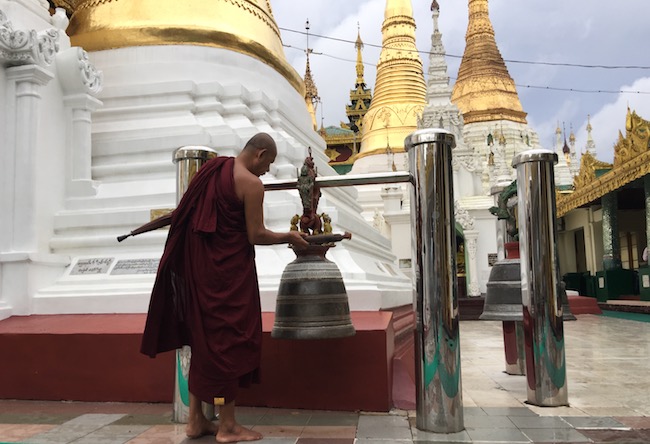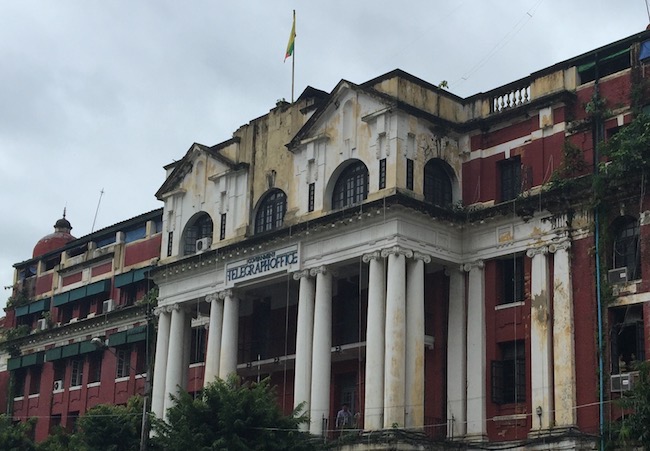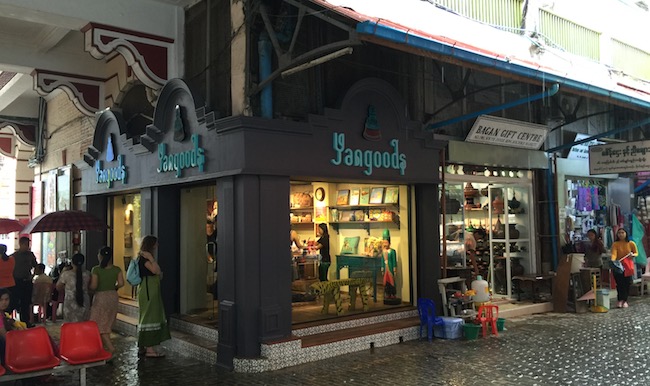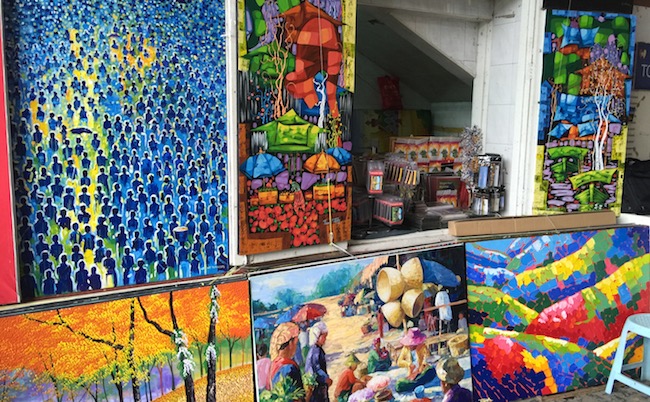
Peering out of the Emirates Boeing 777-300ER flight from Dubai to Yangon, you can see the lazy river. A muddy, sludgy, squidgy creek. Meandering. That is the Irrawaddy – the river that Kipling’s famous Road to Mandalay poem glorifies. No fishes jumping skywards. No hathis pilin’ teak. Just a snake like river engorged with sand and silt making its way past green paddy fields to the sea. 
The mystique of Yangon (Rangoon) does not start when you disembark at the spanking new international airport. It’s when you come out of the airport and see the antique Chevrolet bus with teak and leather interiors that has been arranged by the Belmond tour guides to transport you to the Governor’s Residence, that you realize you are in a city that is waiting to be discovered. 
Fresh squeezed pineapple juice and cold towels are offered to you inside the bus that takes you on a 20 minutes ride from the airport to the colonial Belmond Governor’s Residence. You know you have left Dubai’s desert far behind when you see the luscious green grass and the leafy trees that surround the 1920’s era structure that will be your home for a few nights. Swans and peacocks welcome you to the hotel while the efficient staff escort you up a flight of stairs to a bedroom that has all the creature comforts you require – a tea kettle with plenty of refills and wifi. 
Political issues had cut off Myanmar (Burma) from the world. Mobile telephony penetration was under 1% in 2010 but has now surged to over 50% and tourist arrivals that were minimal are projected to grow to 7.5 million by 2019. If you are one of those who trails the way for others to follow then the new Emirates daily service to Yangon is just for you. In fact, after a 90 minutes stopover in Yangon the Emirates flight continues to Hanoi and you can cover both cities in one trip.
Wherever the British went, they left their colonial architecture behind. And Yangon is no different. The old British era Telegraph House, the General Post Office with its high ceilings and the British Embassy in Rangoon – the Brits have not been able to digest the name change yet! – are all colonial structures built over 100 years ago and are now part of the city’s Heritage sites. 
Downtown Yangon has many street vendors peddling betel nuts, fresh fruit salads, DVDs, inexpensive Chinese mobile phones and even aphrodisiacs. Sitting outside a Hindu temple you can find a medicine man on the footpath selling a variety of herbal concoctions including one called “Vigara: Love for Couple.” Apparently, if prayers are not answered, Vigara [sic] can come in handy.
Myanmar is a Buddhist country and Yangon has several temples that have to be part of every traveler’s itinerary. But to get up close and personal to the saffron wrapped monks we visited a monastery where both male and female monks are trained. The pink fabric clad female novices are allowed to cook while their male counterparts venture door to door every morning to collect food. Just before noon all of them gather in a big dining hall, chant holy prayers and eat their day’s only big meal after which they can just drink water and juice until the next morning. Pretty ascetic lifestyle. Novices who do not feel they are up to it, can opt out once they turn 18. 
The Temple of the Reclining Buddha is one of the major tourist attractions of Yangon. A large reclining Buddha stretching across a vast room greets you when you enter the temple. The head is jewel encrusted and the golden robe makes you feel you are in the midst of royalty. Walk over to see his soles and you will see an intricate pattern with 108 distinguishing marks. For photographers wanting to capture it all there is a raised platform near the feet of the Buddha which gives you a good panoramic view. Be careful as the platform is not selfie-safe!
The most important historical heritage site and tourist attraction in Yangon is, of course, the Shwedagon Pagoda. This shiny, gilded monumental temple of Buddhism is the main reason why Myanmar is called the land of the golden pagodas. Perched on a hillock overlooking Yangon, the Shwedagon Pagoda can be reached by taking a lift to the entrance level – foreigners have their own elevator and everyone has to take off their shoes and socks. The main pagoda is surrounded by dozens of gilded stupas some of which have statues of Buddha and are marked with a weekday. People born on that day pour water over the statue and offer flowers. 
At the very top of of the Shwedagon Pagoda there is a diamond orb which has 4,351 diamonds totaling 1,800 carats. The apex diamond alone is a 76 carat stone. Below the orb is the ‘umbrella’ which is just over 3 meters in height and is made of 500 kgs of gold. And all this is just in the top 4 meters of the 99 meters structure. Visit Yangon and be amazed!
Yangon is street food haven – for those with a stomach made of steel. Unlike Singapore and Malaysia where hygiene standards are above par, in Yangon the normal tourist should only take pictures of the little tea shops where locals go for breakfast, lunch and dinner and for a healthy dose of politics and street gossip.

The upscale Rangoon Tea House is for those who want the same food but in an aseptic clean environment. According to the co-founder and Managing Director, Htet Myet Oo, they only source their chicken and lamb from Halal food suppliers that export Halal meat to the Middle East because these vendors follow high quality standards. However, Muslim travelers should be aware that the Rangoon Tea House also serves pork and alcohol. Vegetarian and fish options are also available.
Myanmar’s economy is growing and those who are benefiting from the economic boom want to spend it in style. For Asian fusion food and an artsy ambience you can go to Port Autonomy, an eclectic new restaurant managed by Kevin Ching, Group Executive Chef of Pun+Projects, a company owned by Ivan Pun, the 30-something Oxford-educated son of one of Myanmar’s richest real estate tycoons. Kevin is a gracious host and if you are lucky he will come and share a meal with you and talk about his culinary skills while directing the staff to make sure that everyone is enjoying the food. The restaurant prides itself in serving fresh produce from the Shan State alongside regional seafood. While Halal meat is not available, there are plenty of vegetarian and seafood options to satiate the Muslim diner. The restaurant is located in a residential area and prices are steep. 
Another trendy restaurant that also doubles as a butchery and a bakery is Sharky’s. Founded by U Ye Htut Win who in 1996 traded in his swanky nightclub in Geneva to become a farmer in his homeland. In a country that was at that time almost inaccessible to foreigners, he started growing vegetables and making cheese which could only be found in Europe. Sharky’s is a great place for having a pizza and a salad. With his own cheese and homegrown vegetables – 80% of his ingredients are from Myanmar – his wood fired oven pizzas are sprinkled with his specialty fleur de sel (hand harvested sea salt) to give them an exquisite taste.
When you are at Sharky’s make sure you watch how a pizza is made – it just takes 2 minutes to convert the dough into a delicious meal.
Every tourist needs to bring home souvenirs. A little object in your living room is a conversation piece that brings back memories of your visit. While Burmah teak is what Myanmar was famous for – the hathis pilin’ teak – it will be difficult to cart a wooden table home so you have to make do with trinkets that fit neatly in your suitcase and can be given away as gifts to your less fortunate colleagues at work or to adorn your home.
Augustine Souvenirs is a treasure trove of antiquities ranging from intricately sculpted brassware and copperware to carved wooden wall hangings to old radios and His Master’s Voice gramophones. Most of the stuff in this shop is meant for those who have enough space for large objects in their living rooms and can afford to have them shipped. 
For the regular tourist on a budget, street vendors near the Sule Pagoda and the Independence Monument are good places for buying souvenirs. When you enter some of the streets and alleys and look up you will find dozens of blue colored satellite dishes sticking out from every apartment – and a mesh of wires crisscrossing above.

I guess Ooredoo, the Qatari company that is one of the telecom operators in Myanmar, will need to introduce their broadband and TV services soon to Myanmar.
For designer shopping a new western styled shopping mall – The Myanmar Plaza – opened in December 2015. With more than 100 shops including a large food court with both local and international fast food outlets, this is the place locals flock to. The 5-star Melia Hotel that is connected to the Myanmar Plaza and opened in August 2016 also offers several fine dining options if you prefer to have a waiter serve you food after a tiring day’s shopping. 
If malls are not what you came to Yangon for, you should head straight to the Bogyoke Aung Sang Market (formerly knows as Scott’s Market). Right by the entrance you will see the creativity of Myanmar’s youth. Colorful paintings are for sale for as little as $40.

Walk in and you will see shops filled with multi-colored longyis and sarongs that are worn by men and women in Myanmar. Ranging in price from $5-$20 you can buy these as gifts for coworkers. But beware, the color runs from the less expensive ones. You do not want to be known as the person who gave a gift that spoiled a full load of clothes in the washing machine. 
Intriguing gifts that you can buy at Bogyoke market include a cowbell attached to a leather belt that once went around a cow’s neck (pricey: around $200) or an intricately designed pipe used for puffing opium (make sure there are no traces left or you may have an unpleasant experience at the airport). You need to spend at least an hour or two at Bogyoke to do it justice as there are numerous shops in the market. Remember, this is not a mall and the shopkeepers expect you to haggle.
About a 5 minutes walk from Bogyoke Market there is a mosque and a few Halal restaurants. Yangon has several mosques and Halal food outlets but as in most non-Muslim countries, the Halal eateries are not the best of places in terms of cleanliness. Pizza, vegetarian or seafood options are advisable for those that do not have a strong constitution.
For rain-starved tourists from Dubai, Yangon has plenty of torrential showers and thunder to offer.
But although it may seem that the taps up above have been left open, the sky clears and the newly washed leaves on the trees at the Belmond Governor’s Residence rustle and sway as we make our way back to the airport to take the Emirates flight from Yangon to Hanoi – where another adventure awaits.



